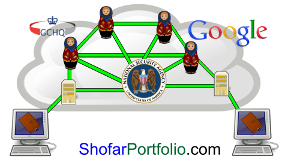|
||||||||||||||||||||||||||||||||||||||||||||||||||||||||||||||||||||||||||||||||||||||||||||||||||||||||||||||||||||||
|
|||
|
|||
|
|
|||
ShofarPortfolio’s Matryoshka Communications uses multiple techniques to not only hide your data, the what of your communications, but hide the metadata, the who, when and where. Matryoshka leaves no traces to the point that there is no evidence that any communications ever takes place. Many technologies are used, such as SyncPackets which are a constant stream of fixed length packets sent between two given computers, and an hourly global reconfiguration of the network based on ShofarDomain’s rootless domain technology. We will focus on cryptograms, the fixed length messages that literally bounce around the global before they reach their destination. While cryptograms can contain any kind of data, including documents, files, chat, audio, and video, we will use an email for our example. For a small email only one cryptogram is required. Larger emails are broken up into multiple cryptograms and sent individually and even using different routes. A cryptogram consists of two fixed size parts, a header and the data. The data is something that is simply passed on to the receiver, which in our example is the email. The header consists of an array of fixed length blocks. Each block contains an IP address of the next Matryoshka Node, and a stamp that is used to anonymously pay the node for the service rendered. When your computer prepares a cryptogram to send, the destination IP address is placed in the header as the first block. The whole cryptogram is then encrypted with the public key from the destination. Next the header in the encrypted cryptogram is shifted to make room for a new block. The IP address and stamp for a Matryoshka Node is put in the block and the cryptogram is encrypted again using the public key for the new node. This process repeats a random number of times. Finally your computer will send the cryptogram embedded in SyncPackets to the first node. When a Matryoshka Node receives a cryptogram it reverses the process by one step. The cryptogram is decrypted with the node’s private key. The data remains encrypted and therefore useless for this node. The only part of the header that is no longer encrypted is the first block. The rest of the header is shifted back by one block. The node now knows where to send the cryptogram next and can use the stamp to get paid. This process repeats until the final destination receives the cryptogram and can decrypt the data for the last time. Each Matryoshka Node along the path can only determine where the cryptogram came from and where it is going to. A node cannot determine how many other nodes came before or will come after. This means that if a Matryoshka Node was operated by a party that wanted to know about your data, there is nothing in the cryptogram that will connect it to you or anyone else. This has been a simplified overview of cryptograms in Matryoshka Communication from ShofarPortfolio. For more information visit ShofarPortfolio.com. |
|||
|
|
||||||


